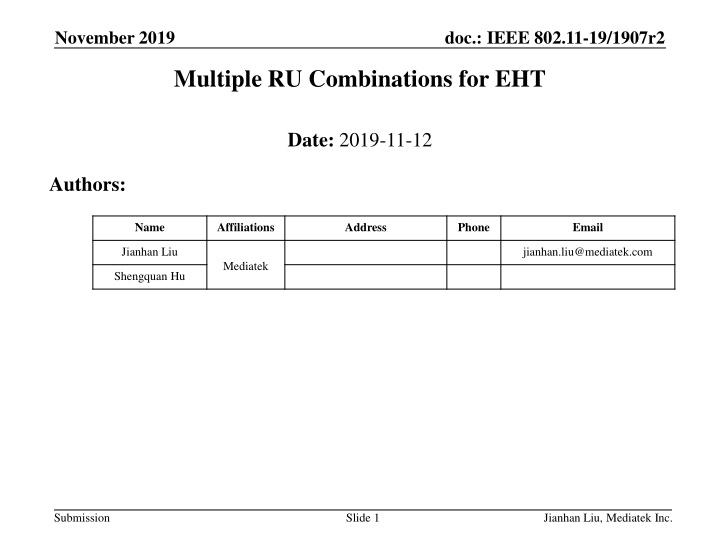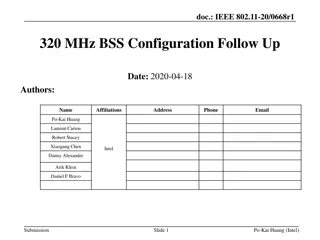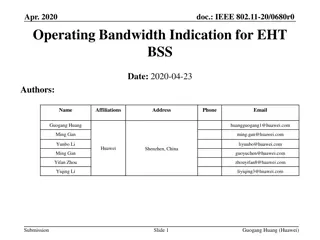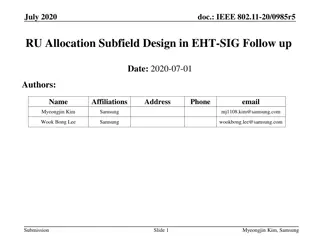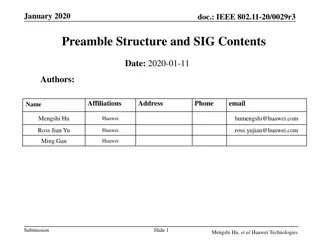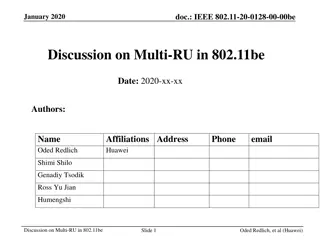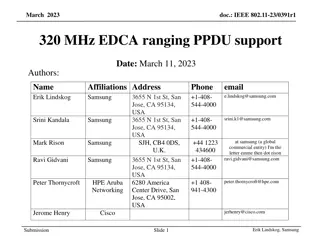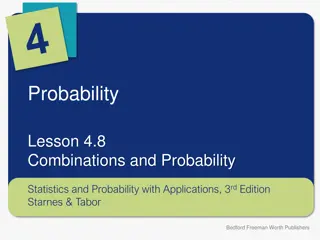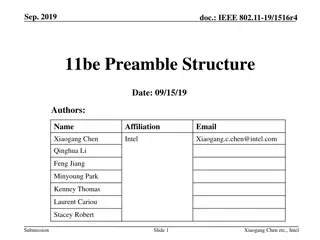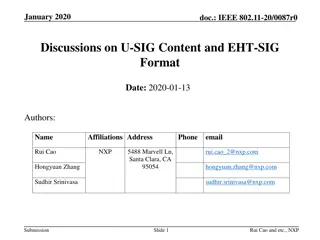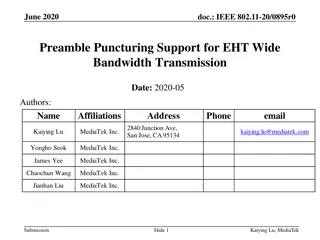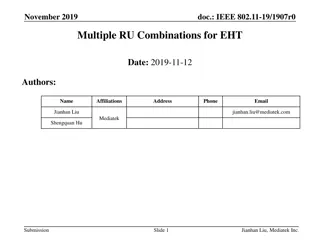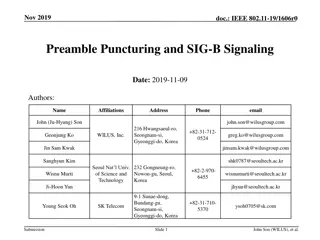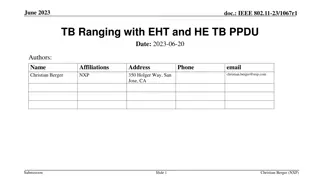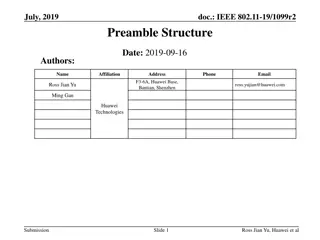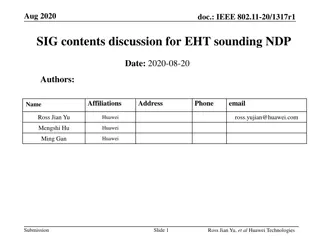IEEE 802.11-19/1907r2 Multiple RU Combinations for EHT
11be task group approved multiple RU combinations for PPDU BW up to 160MHz. Principles outlined to limit combined RUs, focusing on spectrum use enhancement. Useful scenarios discussed for small-size RU combinations within 20MHz and 40MHz bands. Considerations highlighted regarding combining different RU sizes for optimal spectrum use.
Download Presentation

Please find below an Image/Link to download the presentation.
The content on the website is provided AS IS for your information and personal use only. It may not be sold, licensed, or shared on other websites without obtaining consent from the author.If you encounter any issues during the download, it is possible that the publisher has removed the file from their server.
You are allowed to download the files provided on this website for personal or commercial use, subject to the condition that they are used lawfully. All files are the property of their respective owners.
The content on the website is provided AS IS for your information and personal use only. It may not be sold, licensed, or shared on other websites without obtaining consent from the author.
E N D
Presentation Transcript
November 2019 doc.: IEEE 802.11-19/1907r2 Multiple RU Combinations for EHT Date: 2019-11-12 Authors: Name Affiliations Address Phone Email Jianhan Liu jianhan.liu@mediatek.com Mediatek Shengquan Hu Submission Slide 1 Jianhan Liu, Mediatek Inc.
November 2019 doc.: IEEE 802.11-19/1907r2 Introduction 11be task group has approved the following motion [1]: 11be shall allow more than one RUs to be assigned to a single STA Coding and interleaving schemes for multiple RUs assigned to a single STA are TBD. Maximum number of RUs (>1) assigned to a single STA is also TBD. 11be task group has also approved the following motion [1]: 11be uses the same subcarrier spacing for the data portion of EHT PPDU as 11ax data portion. This means that up to 160/80+80 MHz, the tone plan shall be same as 11ax. In this contribution, we consider the possible multiple RU combinations for PPDU BW is less or equal to 160MHz. Submission Slide 2 Jianhan Liu, Mediatek Inc.
November 2019 doc.: IEEE 802.11-19/1907r2 Multiple RU Combination Design Principle To avoid the design and testing complexity, to balance the complexity and spectrum efficiency, we think the following principles are reasonable. Limit the number of RUs that can be combined Allowing combine large number of RUs causes the exponential growth of possible RU combinations. Reduce the multiple RU combinations, only the useful and reasonable combinations should be introduced. Allowing all the possible RU combinations increases the difficulty of scheduling. Main focus is to enhance the spectrum use, not frequency diversity. Compared to spectrum use enhancement, diversity provides limited gain. Submission Slide 3 Jianhan Liu, Mediatek Inc.
November 2019 doc.: IEEE 802.11-19/1907r2 Useful Scenarios of Small-size RU Combinations In 2.4GHz band, only 20MHz and 40MHz BW are allowed. So the small-size RU combinations within 20MHz and 40MHz should be considered. For 20MHz BW, RU26 is over 10% of the spectrum. For 2 user OFDMA transmissions, center 26 tone RU is always wasted if multiple RU combination for 20MHz BW is not allowed. For preamble puncture cases in 80MHz and above, to meet the spectral mask (reduce the interference to the punctured adjacent 20MHz channels), edge 26 RU (#9 RU in the figure) should not be assigned to any user. So the combination of RU52 and the RU26 adjacent to the edge RU26 is useful (#3 RU52+#8 RU26 in the figure). Punctured sub-channel Can be used for normal transmssion Frequency segments need spectial care P20 S20 26-tone 1 2 3 4 6 7 8 9 10 11 12 13 15 16 17 18 20 21 22 23 25 26 27 28 29 30 31 32 34 35 36 37 1 2 5 3 4 5 6 14 7 8 9 10 24 11 12 13 14 33 15 16 52-tone 1 2 3 4 19 5 6 7 8 106-tone 1 2 3 4 242-tone 1 2 484-tone 996-tone 1 Submission Slide 4 Jianhan Liu, Mediatek Inc.
November 2019 doc.: IEEE 802.11-19/1907r2 Considerations on RU Combination It is not reasonable to combine a small-size RU with a large-size RU, for example, combine a RU26 with a RU484 do not increase the spectrum use much. Based on 802.11 tradition on 20MHz channelization, we can separate RUs into large-size RUs and small-size RUs. RUs with equal to or more than 242 tones are called as large-size RUs RU242, RU484, RU 996 and RU 996x2 are regarded as large size RUs RUs with less than 242 tones as small-size RUs RU26, RU52 and RU106 are regarded small-size RUs General RU Combination considerations: Do not combine small-size RUs with large-size RUs Small-size RUs combine with small-size RUs Large-size RUs combine with large-size RUs Submission Slide 5 Jianhan Liu, Mediatek Inc.
November 2019 doc.: IEEE 802.11-19/1907r2 Considerations on Small-size RU Combination It is not reasonable to combine small-size RUs across 20MHz boundary. It only provides diversity gain, not enhancing spectral efficiency much. It will significantly increase the number of RU combinations. To reduce the number of RU combinations, for small-size RU combinations, only the combinations of contiguous small-size RUs should be introduced. Allowing non-contiguous small-size RU combinations only provides diversity gain, not spectral efficiency enhancement. RU combinations of RU26+RU26 and RU52+RU52 are not useful because Instead of allocating two RU26 to one STA, AP can allocate one RU52 to that station. Instead of allocating two RU52 to one STA, AP can can allocate one RU106 to that station. Submission Slide 6 Jianhan Liu, Mediatek Inc.
November 2019 doc.: IEEE 802.11-19/1907r2 Proposal on RU106 and RU26 combinations For 20 and 40 MHz, within 20MHz boundary, any contiguous RU26 and RU106 can be combined. For 80MHz, to reduce the combination mode, within each 20MHz, only one combination RU126+RU26 is introduced (as colored in orange). These combinations enhance the spectral efficiency for OFDMA cases with 8 users. For 160MHz BW, each 80MHz segment allows the same the combinations of RU126+RU26 as in 80MHz BW. Submission Slide 7 Jianhan Liu, Mediatek Inc.
November 2019 doc.: IEEE 802.11-19/1907r2 Proposal on RU52 and RU26 combinations For 20MHz and 40MHz BW, the combination of contiguous inner RU52 with RU26 are introduced (as colored in blue). For 80MHz BW, to reduced the number of combinations, only the combinations helpful for punctured cases are introduced (as colored in Blue). For 160MHz BW, each 80MHz segment allows the same the combinations of RU52+RU26 as in 80MHz BW. Submission Slide 8 Jianhan Liu, Mediatek Inc.
March 2019 doc.: IEEE 802.11-19/1907r2 Diversity Gain Evaluation for non-contiguous small RU combinations M-RU Assignment Mode: (e.g. assume with BW20, only two RUs aggregated) Mode-0: non-adaptive for RU106+RU26; adaptively switched between two RU52+RU26 combinations; continous Mode-1: semi-adaptive: i.e. only larger RU (e.g. RU52) is adaptively selected; RU26 is selected adjacent with selected RU26; continuous Mode-2: full-adaptive: i.e. both RUs are adaptively selected with BW20; may non-continuous BW20, D-NLOS, 1SS -10 BW20, D-NLOS, 1SS -10 Mode-2 Mode-1 -15 -15 RU52 RU52 RU26 -20 -20 RU26 -25 Channel-Power (in dB) -25 Channel-Power (in dB) -30 -30 -35 -35 -40 -40 -45 -45 -50 -50 50 100 150 200 250 50 100 150 200 250 Tone-Index Tone-Index Submission Slide 9 Jianhan Liu, Mediatek Inc.
March 2019 doc.: IEEE 802.11-19/1907r2 RU52+RU26: MCS4, BF/4x1 BW20,RU52+RU26,LDPC,Estimated Channel,PktLen=2KB,D-NLOS, BF,4x1,1ss,MCS: [4 4] 0 10 RuSelMode-0: sensSNR=11.04dB RuSelMode-1: sensSNR=10.52dB RuSelMode-2: sensSNR=10.09dB MCS4, 4x1 PER -1 10 -2 10 7 8 9 10 11 12 13 14 SNR (dB) Submission Slide 10 Jianhan Liu, Mediatek Inc.
March 2019 doc.: IEEE 802.11-19/1907r2 RU52+RU26: MCS7, BF/4x1 BW20,RU52+RU26,LDPC,Estimated Channel,PktLen=2KB,D-NLOS, BF,4x1,1ss,MCS: [7 7] 0 10 RuSelMode-0: sensSNR=17.62dB RuSelMode-1: sensSNR=17.42dB RuSelMode-2: sensSNR=16.65dB MCS7, 4x1 PER -1 10 -2 10 14 15 16 17 18 19 20 SNR (dB) Submission Slide 11 Jianhan Liu, Mediatek Inc.
March 2019 doc.: IEEE 802.11-19/1907r2 RU52+RU26: MCS4, BF/4x2 BW20,RU52+RU26,LDPC,Estimated Channel,PktLen=2KB,D-NLOS, BF,4x2,2ss,MCS: [4 4] 0 10 RuSelMode-0: sensSNR=15.38dB RuSelMode-1: sensSNR=14.90dB RuSelMode-2: sensSNR=14.30dB MCS4, 4x2 PER -1 10 -2 10 9 10 11 12 13 14 15 16 17 18 19 SNR (dB) Submission Slide 12 Jianhan Liu, Mediatek Inc.
March 2019 doc.: IEEE 802.11-19/1907r2 RU52+RU26: MCS7, BF/4x2 BW20,RU52+RU26,LDPC,Estimated Channel,PktLen=2KB,D-NLOS, BF,4x2,2ss,MCS: [7 7] 0 10 RuSelMode-0: sensSNR=22.45dB RuSelMode-1: sensSNR=21.81dB RuSelMode-2: sensSNR=21.11dB MCS7, 4x2 PER -1 10 -2 10 12 14 16 18 20 22 24 26 28 SNR (dB) Submission Slide 13 Jianhan Liu, Mediatek Inc.
March 2019 doc.: IEEE 802.11-19/1907r2 RU106+RU26: MCS4, BF/4x1 BW20,RU106+RU26,LDPC,estimated-CE,PktLen=2KB,D-NLOS,BF,4x1, 1ss,MCS: [4 4] 0 10 RuSelMode-0: sensSNR=11.14dB RuSelMode-1: sensSNR=10.47dB RuSelMode-2: sensSNR=10.34dB MCS4, 4x1 PER -1 10 -2 10 4 5 6 7 8 9 10 11 12 13 14 SNR (dB) Submission Jianhan Liu, Mediatek Inc. Slide 14
March 2019 doc.: IEEE 802.11-19/1907r2 RU106+RU26: MCS7, BF/4x1 BW20,RU106+RU26,LDPC,estimated-CE,PktLen=2KB,D-NLOS,BF,4x1, 1ss,MCS: [7 7] 0 10 RuSelMode-0: sensSNR=17.89dB RuSelMode-1: sensSNR=17.38dB RuSelMode-2: sensSNR=16.99dB MCS7, 4x1 PER -1 10 -2 10 10 12 14 16 18 20 22 SNR (dB) Submission Jianhan Liu, Mediatek Inc. Slide 15
March 2019 doc.: IEEE 802.11-19/1907r2 RU106+RU26: MCS4, BF/4x2 BW20,RU106+RU26,LDPC,estimated-CE,PktLen=2KB,D-NLOS,BF,4x2, 2ss,MCS: [4 4] 0 10 RuSelMode-0: sensSNR=16.24dB RuSelMode-1: sensSNR=15.15dB RuSelMode-2: sensSNR=15.06dB MCS4, 4x2 PER -1 10 -2 10 10 11 12 13 14 15 16 17 18 19 SNR (dB) Submission Jianhan Liu, Mediatek Inc. Slide 16
March 2019 doc.: IEEE 802.11-19/1907r2 RU106+RU26: MCS7,BF/4x2 BW20,RU106+RU26,LDPC,estimated-CE,PktLen=2KB,D-NLOS,BF,4x2, 2ss,MCS: [7 7] 0 10 RuSelMode-0: sensSNR=23.50dB RuSelMode-1: sensSNR=22.26dB RuSelMode-2: sensSNR=22.18dB MCS7, 4x2 PER -1 10 -2 10 16 17 18 19 20 21 22 23 24 25 26 27 SNR (dB) Submission Jianhan Liu, Mediatek Inc. Slide 17
November 2019 doc.: IEEE 802.11-19/1907r2 Considerations on large-size RU combinations For combinations of large-size RUs (RU242, RU484, RU 996 and RU 996x2), the main idea is to enhance the spectral efficiency in the preamble punctured cases for DFS channel and incumbent signals. To reduce the number of combinations, we propose the following combinations For 80MHz BW, introducing RU combination RU242+RU484 (both contiguous and non-contiguous) It is not useful to introduce RU combinations of RU242+RU242 because a single RU484 has the same spectral efficiency as combinations of RU242+RU242. Maybe non-contiguous combination of RU242+RU242 is useful in preamble punctured cases for SU. Submission Slide 18 Jianhan Liu, Mediatek Inc.
November 2019 doc.: IEEE 802.11-19/1907r2 Considerations on large-size RU combinations (cont s) For BW>=160MHz Within each 80MHz segment RU combination RU242+RU484 (both contiguous and non-contiguous) Crossing 80MHz RU combinations of RU484+RU996 RU combinations of RU242+484+RU242+484 RU combinations of RU242+484+RU996 Submission Slide 19 Jianhan Liu, Mediatek Inc.
November 2019 doc.: IEEE 802.11-19/1907r2 Straw Poll #1 Do you agree that small-size RUs can only combine with small-size RUs and large-size RUs can only combine with large-size RUs? RUs with equal to or more than 242 tones are called as large-size RUs RUs with less than 242 tones as small-size RUs Submission Slide 20 Jianhan Liu, Mediatek Inc.
March 2019 doc.: IEEE 802.11-19/1907r2 Motion #1 Move to add the following into 11be SFD: Small-size RUs can only be combine with small-size RUs and large-size RUs can only be combine with large-size Rus. RUs with equal to or more than 242 tones are defined as large-size RUs RUs with less than 242 tones are defined as small-size RUs Submission Slide 21 Jianhan Liu, Mediatek Inc.
November 2019 doc.: IEEE 802.11-19/1907r2 Straw Poll #2 Do you agree that combination of small-size RUs shall not cross 20MHz channel boundary? Submission Slide 22 Jianhan Liu, Mediatek Inc.
March 2019 doc.: IEEE 802.11-19/1907r2 Motion #2 Move to add the following into 11be SFD: Combination of small-size RUs shall not cross 20MHz channel boundary. Submission Slide 23 Jianhan Liu, Mediatek Inc.
November 2019 doc.: IEEE 802.11-19/1907r2 Straw Poll #3 Do you agree that only allowed small-RU combinations are RU126+RU26 and RU52+RU26? Submission Slide 24 Jianhan Liu, Mediatek Inc.
March 2019 doc.: IEEE 802.11-19/1907r2 Motion #3 Move to add the followings into 11be SFD: Only allowed small-RU combinations are RU126+RU26 and RU52+RU26. Submission Slide 25 Jianhan Liu, Mediatek Inc.
November 2019 doc.: IEEE 802.11-19/1907r2 Straw Poll #4 Do you agree that for 20 and 40 MHz PPDU, within 20MHz boundary, any contiguous RU26 and RU106 can be combined? Submission Slide 26 Jianhan Liu, Mediatek Inc.
March 2019 doc.: IEEE 802.11-19/1907r2 Motion #4 Move to add the followings into 11be SFD: For 20 and 40 MHz PPDU, within 20MHz boundary, any contiguous RU26 and RU106 can be combined. Submission Slide 27 Jianhan Liu, Mediatek Inc.
November 2019 doc.: IEEE 802.11-19/1907r2 Straw Poll #5 Do you agree that for 80MHz BW, only the orange colored RU combinations are allowed? SP Not reach 75% approval. Submission Slide 28 Jianhan Liu, Mediatek Inc.
November 2019 doc.: IEEE 802.11-19/1907r2 Straw Poll #6 Do you agree that for 20 and 40 MHz PPDU, the blue colored combination of RU52 and RU26 are allowed? Submission Slide 29 Jianhan Liu, Mediatek Inc.
March 2019 doc.: IEEE 802.11-19/1907r2 Motion #6 Move to add the followings into 11be SFD: For 20 and 40 MHz PPDU, the blue colored combination of RU52 and RU26 are allowed. Submission Slide 30 Jianhan Liu, Mediatek Inc.
November 2019 doc.: IEEE 802.11-19/1907r2 Straw Poll #7 Do you agree that for 80MHz PPDU, the blue colored combination of RU52 and RU26 are allowed? Submission Slide 31 Jianhan Liu, Mediatek Inc.
March 2019 doc.: IEEE 802.11-19/1907r2 Motion #7 Move to add the followings into 11be SFD: For 80MHz PPDU, the blue colored combination of RU52 and RU26 are allowed. Submission Slide 32 Jianhan Liu, Mediatek Inc.
